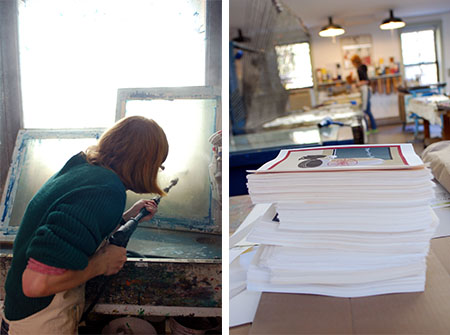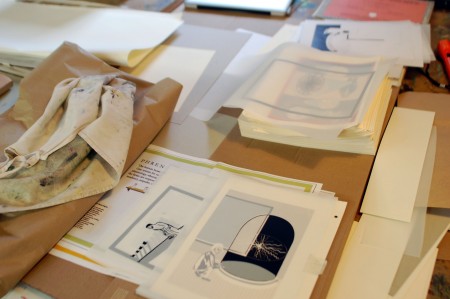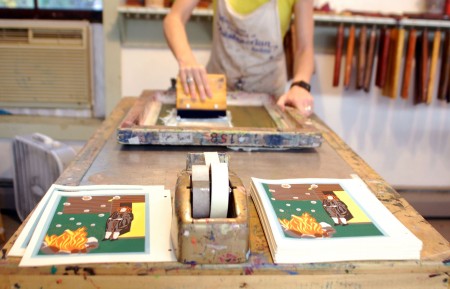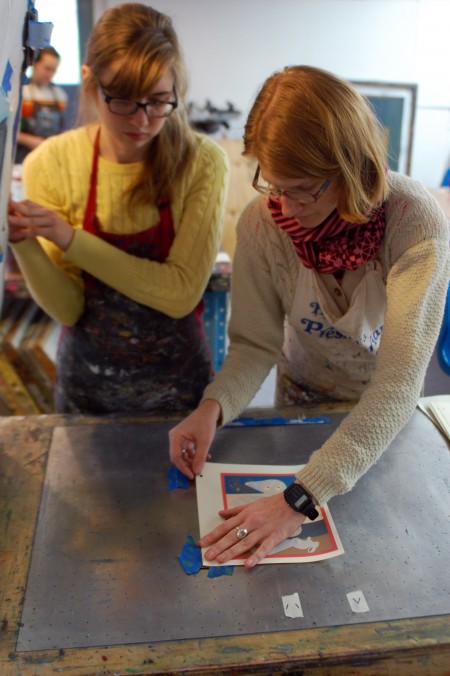Illuminated Histories: Alison Byrnes In the Studio
October 31, 2013Over the next few weeks, we’re tracking our resident Alison Byrnes’s book project Scientific Theories Once Widely Believed, Since Proven Wrong. This is the first post in the series.
It seems that Alison Byrnes has been screenprinting all day, every day. In just over three short weeks, she’s run off 100 of each of the ten prints that will make up her book Scientific Theories Once Widely Believed, Since Proven Wrong. Each print has at least ten colors, which means upwards of ten layers per print—a separate run for each color.
Including proofs and bad prints, Alison estimates she’s made 20,000 squeegee strokes. What’s more, Alison is a painter by training; she only learned how to screen print when she arrived at WSW for her Art-in-Education Book Arts Residency Grant.
“Chris [Petrone] had me do a run of a six color print to see what it was like, maybe to scare me,” Alison laughs. She initially tried to get each print down into two or three colors, but to translate Alison’s quirky visual style, two or three colors wasn’t going to be enough. “That test print ended up having 13 colors.”


Scientific Theories Once Widely Believed, Since Proven Wrong presents ten delightfully incorrect scientific theories such as the cosmological constant, the four humors, phrenology, alchemy, and geocentricism. From our 21st century vantage these theories, which range from the ancient to early modern periods, look absurd, eccentric, and comical. It’s the perfect project for Alison, who considers history through a humorous, fluid, anachronistic lens.
“History should be flexible depending on who is thinking about it,” she says. “I’m all about having fun with it and acknowledging that pop culture is a valid way of thinking about history.”
Alison is interested in how historical accounts are imagined and visualized by contemporary readers, how we fill in details missing from textual accounts with our own subjective visual worlds. After studying Latin and Classics in college, she began painting cheeky vignettes of historical figures displaced in place and time: Louis XIV doing a load of whites at the laundromat, Julius Caesar at the barber shop, Napoleon filling up at the gas station. As her work developed, she began identifying and focusing on patterns in historical narratives across time and cultures.
Alison’s figures inhabit a space where objects don’t quite overlap, perspectives don’t quite jibe, and the most important things get to be the biggest, regardless of the natural order of things. In The Planet Vulcan —which tells the story of the 19th century “discovery” of a hypothetical planet between Mercury and the sun—Urbain Le Verrier and Edmond Lescarbault seem to sit both inside, outside, and on top of their observatory as they turn their telescopes toward large planets and an even larger sun.
“Paintings based on photographs are very boring—I don’t want to agonize over the drawing,” Alison says. “I play a lot with scale to convey meaning, and because narrative is so important in my work, nothing can be obscured. It’s all very stage-like.”
The controlled awkwardness of Alison’s style is inspired by the history of visual storytelling itself. In particular, she references illuminated manuscripts and Indian miniature paintings and the way they play with scale, perspective, and space in order to convey stories in a single image. Flat and stylized, medieval illuminations are the ornate illustrations and marginalia decorating unique, handwritten books of the middle ages. Similarly, Mughal miniatures, which developed in books in 16th – 19th century South Asia, illustrate and interpret narratives in a highly-detailed, colorful, flattened space.
“The illuminations and Indian miniatures are not trying to be a window into the world with correct perspective and proportion. It’s all kind of a trick,” Alison explains. “And I have this thing about subjectivity, that we should proclaim subjectivity—like, ‘This is my point of view’ and not, ‘This is the truth of what happened.’”
In a book, Alison’s prints will function much the same way that illuminations and miniatures functioned in manuscripts. For each theory in Scientific Theories Once Widely Believed, Since Proven Wrong, a page of digitally-printed text will contextualize Alison’s imagery (and vice versa). Text and image will tell the same story, though in radically different ways, each filling in details missing in the other.
With four weeks to go and all her finished prints stacked up neatly, it’s time to prep her silk covers, finalize her complex gatefold structure, and begin production. The printing is officially over, but Alison can’t help sneaking back into her older prints to add “bonus layers” for a little extra pizzazz.
“I don’t need to print any more,” she says. Her new parameter for additional printing: “Only in my spare time!”
Alison Byrnes holds bachelors degrees in Classics and Art from the University of Wisconsin, Madison, and an MFA and Museum Studies Certificate from the University of Michigan, Ann Arbor. She has been living and working in Bangalore, India for the last 5 years, where she teaches at the Srishti School of Art, Design & Technology. Check out more of her work at alisonbyrnes.com and see more images of her residency here.






